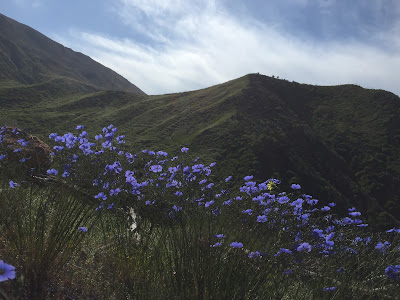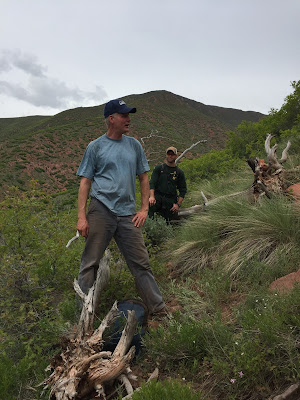 |
| (South Canyon staff ride participants* with varied backgrounds and perspectives discuss Human Factors near H-2. Photo credit: Paul Hohn) |
(Taken from Leading in the Wildland Fire Service, p. 31)
Everyone starts with an initial perception of any given situation and then continuously updates it with new information. People gather information through both observation, which includes input from the senses, and communication, which includes face-to-face conversation, written communication, and radio or telephone exchanges.
Simply paying attention is an important part of maintaining good situation awareness, but even more important is determining what to pay attention to. All perceptions are subject to filtering and focusing: people constantly filter information and shift focus. People also produce a lot of internal inputs such as thoughts about what to do next, stress, memories of similar experiences, fear. Those with more experience in an environment often can more easily filter out distractions and unimportant details and focus on the most salient information.
A Recent Example
The 2016 Rocky Mountain South Canyon Staff Ride provides a great example of the breadth and depth of a mixed audience and the importance such mix contributes to the safety and leadership of all firefighters.
The mixed audience included newly-hired firefighters to those with 25 years of experience to line officers with varied experience. Senior leadership participants included Curtis Heaton (USFS Region 2, Fire Director), Julian Affuso (USFS Region 2, Deputy Fire Director), and Jaque Buhanan (then Deputy Regional Forester, now Acting Regional Forester). Cadre members included the senior leadership of Kyle Cowan (Wyoming BLM, State FMO) and Todd Richardson (Colorado BLM, State FMO).
The mixed audience included newly-hired firefighters to those with 25 years of experience to line officers with varied experience. Senior leadership participants included Curtis Heaton (USFS Region 2, Fire Director), Julian Affuso (USFS Region 2, Deputy Fire Director), and Jaque Buhanan (then Deputy Regional Forester, now Acting Regional Forester). Cadre members included the senior leadership of Kyle Cowan (Wyoming BLM, State FMO) and Todd Richardson (Colorado BLM, State FMO).
 |
| Wildflowers on the Memorial Trail looking at the west flank fireline |
A special thanks to Paul Hohn (Wyoming BLM, Assistant State FMO) for providing the basis for this post, providing the pictures, and his continued support of leadership development.
*Foreground from Left to Right: Trevor Keenan - Firefighter, Gunnison National Forest, Jacque Buchanan - acting Regional Forester, USFS Rocky Mountain Region, Derrick Holdstock- Regional Fire Management Coordinator,Texas Parks and Wildlife Dept.)


No comments:
Post a Comment